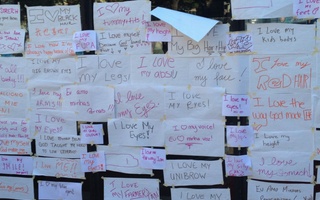Residents also raised concerns in the early 2000s that the groups of people constantly congregating in the Pit created a potentially dangerous congestion problem.
In 2007 construction started on the Super Crosswalk Plan as part of the Harvard Square Improvement Project, which extended walking space and subsequently decrease congestion in the Pit. City officials report that there have been fewer complaints since the project was completed in 2008.
AN URBAN STAGE
Designed to facilitate spontaneous community performances, the Pit is much more than just home to the main entrance to the subway. It was built in 1985, at the conclusion of a process to extend the Red Line out to Alewife. Musicians, artists, homeless people, tourists, and protestors are all among the groups that use the space as a public gathering place.
In the 1960s, the Square was an early performing venue for folk singers Baez and Dylan, and the roaming lifestyle of that era has continued to define the Pit.
In the 1980s and ’90s, the Square became a gathering place for the Punk counterculture youth movement.
For $40 per year, performers and protestors—such as the Tibetan monks who often demonstrate there—can obtain licenses to perform in the Pit.
One such performer, Donald Heller of the Hurdy Gurdy Band, has been playing his hurdy gurdy—a type of violin that sounds similar to a bag-pipe—in or around the Pit for the past month.
After playing for two years on the streets of Europe, he and his wife Anicet Heller moved to Boston to be closer to their sons, one of whom goes to the Boston Conservatory of Music. Heller obtained a street performing license and, although it will expire at the end of the year, he said it worth the $40 for the few remaining months.
“It is a comfortable place for buskers [street performers]. That is what keeps me here” said Heller. He said that while the streets of Munich and Berlin have more open space for pedestrians, the Pit and the large sidewalk in front of Crema Cafe are good for performance. He also noted that the provisions that the city makes for performers are attractive to musicians.
“Our street performers are completely organic, there is complete serendipity,” Denise A. Jillson of the Harvard Square Business Association said. “They can show up in the morning and stay as long as they wish.”
GOOD FOR BUSINESS
In 2003, during the planning process for the Harvard Square Improvement Project, a City Council appointed committee concluded that because the Pit is a visible, public area, it is relatively safe. Furthermore, the committee said, if people were not allowed to hang out there, they might start congregating in less visible areas and could potentially pose a more significant safety issue.
But safety concerns do not appear to weigh heavily on the minds of local business owners.
Rather, business owners were happy to point to the Pit as a source of costumers and a unique aspect of Harvard Square.
Read more in News
Senior Fellow Leaves BoardRecommended Articles
-
Ball FourIf watching football is anything like playing, I think I have a pretty good idea of what it felt like
-
Strangers In Our MidstIn the middle of the day only a few businesspeople, construction workers and local shopkeepers sit on the brick benches
-
A Man With a Machete is On the LooseThe Cambridge police are looking for a man with a machete.
-
Wanted: RoadiesWhat do you get by bringing together two aspiring doctors, an astrophysicist, a public servant, a religion expert and a ...
-
15 ListNow that construction plans in Allston have been paused indefinitely, here are FM’s suggestions for what Harvard can do with ...
-
 #lovethyself
#lovethyself













